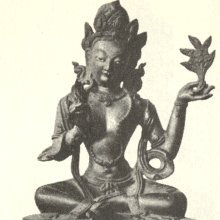Kshantiparamita, Kṣāntipāramitā, Kshanti-paramita: 6 definitions
Introduction:
Kshantiparamita means something in Buddhism, Pali, Hinduism, Sanskrit. If you want to know the exact meaning, history, etymology or English translation of this term then check out the descriptions on this page. Add your comment or reference to a book if you want to contribute to this summary article.
The Sanskrit term Kṣāntipāramitā can be transliterated into English as Ksantiparamita or Kshantiparamita, using the IAST transliteration scheme (?).
Images (photo gallery)
In Buddhism
Mahayana (major branch of Buddhism)
Source: Wisdom Library: Maha Prajnaparamita SastraKṣāntipāramitā (क्षान्तिपारमिता) refers to the “virtue of patience” and represents one of the six perfections (pāramitā). How does the Bodhisattva fulfill the virtue of patience (kṣāntipāramitā)? Answer: When people come to insult him, strike him, beat him, slash him, tear off his skin, cut him to pieces and take his life, his mind feels no hatred (dveṣa). Thus, when king Kali cut off his hands (hasta), feet (pāda), ears (karṇa) and nose (nāsā), the Bhikṣu Kṣānti kept a strong mind (dṛḍhacitta) without emotion (acala).
Source: academia.edu: A Study and Translation of the GaganagañjaparipṛcchāKṣāntipāramitā (क्षान्तिपारमिता) refers to the “perfection of tolerance”, according to the Gaganagañjaparipṛcchā: the eighth chapter of the Mahāsaṃnipāta (a collection of Mahāyāna Buddhist Sūtras).—Accordingly, “How then, son of good family, does the Bodhisattva collect all qualities of the Buddha by thorough practice (yoniśas-prayoga)? [...] The tolerance and mildness (kṣāntisauratya) are the causes which are the ornaments of body, speech and thought (kāyavākcitta-alaṃkāra); the Bodhisattva practices what is good for oneself and for others (ātmaparahita) through the ornaments of body, speech and thought; he, having transferred the basis of wishing to help and tolerance into omniscience, fulfils the perfection of tolerance (kṣāntipāramitā)”.

Mahayana (महायान, mahāyāna) is a major branch of Buddhism focusing on the path of a Bodhisattva (spiritual aspirants/ enlightened beings). Extant literature is vast and primarely composed in the Sanskrit language. There are many sūtras of which some of the earliest are the various Prajñāpāramitā sūtras.
Tibetan Buddhism (Vajrayana or tantric Buddhism)
Source: archive.org: The Indian Buddhist IconographyKṣāntipāramitā (क्षान्तिपारमिता) refers to one of twelve Pāramitā Goddesses in human form, as commonly depicted in Buddhist Iconography, and mentioned in the 11th-century Niṣpannayogāvalī of Mahāpaṇḍita Abhayākara.—Her Colour is yellow; her Symbol is a white lotus; she has two arms.
Kṣāntipāramitā is described in the Niṣpannayogāvalī (dharmadhātuvāgīśvara-maṇḍala) as follows:—
“Kṣāntipāramitā is of yellow colour and holds in her left hand the white lotus”.
[Her right hand as usual holds the cintāmaṇi banner, A statue of this deity is to be found in China.
The twelve deities collectively have their spiritual father in Ratnasambhava. [...] According to a statement in the maṇḍala all the deities [viz., Kṣāntipāramitā] are two-armed, and they hold in the right hand the flag marked with the Cintāmaṇi jewel, and in the left their special symbols. Prajñāpāramitā is an exception since she has two more hands.]

Tibetan Buddhism includes schools such as Nyingma, Kadampa, Kagyu and Gelug. Their primary canon of literature is divided in two broad categories: The Kangyur, which consists of Buddha’s words, and the Tengyur, which includes commentaries from various sources. Esotericism and tantra techniques (vajrayāna) are collected indepently.
General definition (in Buddhism)
Source: Wisdom Library: Dharma-samgrahaKṣāntipāramitā (क्षान्तिपारमिता) or simply kṣānti refers to the “perfection of patience” and represents the third of the “six perferctions” (ṣaṭpāramitā) as defined in the Dharma-saṃgraha (section 17). The Dharma-samgraha (Dharmasangraha) is an extensive glossary of Buddhist technical terms in Sanskrit (e.g., ṣaṣ-pāramitā and kṣānti-pāramitā). The work is attributed to Nagarjuna who lived around the 2nd century A.D.
Kṣāntipāramitā forms, besides a part of the “six perferctions” (ṣaṭpāramitā), also a part of the “ten perfections” (daśa-pāramitā).
Languages of India and abroad
Sanskrit dictionary
Source: Cologne Digital Sanskrit Dictionaries: Monier-Williams Sanskrit-English DictionaryKṣāntipāramitā (क्षान्तिपारमिता):—[=kṣānti-pāramitā] [from kṣānti > kṣam] f. the Pāramitā or accomplishment of indulgence, [Kāraṇḍa-vyūha]
[Sanskrit to German]
Sanskrit, also spelled संस्कृतम् (saṃskṛtam), is an ancient language of India commonly seen as the grandmother of the Indo-European language family (even English!). Closely allied with Prakrit and Pali, Sanskrit is more exhaustive in both grammar and terms and has the most extensive collection of literature in the world, greatly surpassing its sister-languages Greek and Latin.
See also (Relevant definitions)
Partial matches: Kshanti, Paramita.
Full-text: Kshamana, Kshanti, Shatparamita, Six Perfections, Dashaparamita, Ten Perfections, Dridhacitta, Atmaparahita.
Relevant text
Search found 11 books and stories containing Kshantiparamita, Kṣāntipāramitā, Kshanti-paramita, Kṣānti-pāramitā, Ksantiparamita, Ksanti-paramita; (plurals include: Kshantiparamitas, Kṣāntipāramitās, paramitas, pāramitās, Ksantiparamitas). You can also click to the full overview containing English textual excerpts. Below are direct links for the most relevant articles:
Maha Prajnaparamita Sastra (by Gelongma Karma Migme Chödrön)
Part 9 - Fulfilling the perfections skillfully < [Chapter XLIX - The Four Conditions]
Part 2 - Practicing the six perfections < [Chapter XLV - Application of Merit]
Vimalakirti Nirdesa Sutra (by Charles Luk)
Ksitigarbha Bodhisattva fundamental vow sutra (by Johnny Yu)
Prajnaparamita in Buddhist < [November-December 1931]
A History of Indian Philosophy Volume 1 (by Surendranath Dasgupta)
Part 11 - Mahāyānism < [Chapter V - Buddhist Philosophy]

